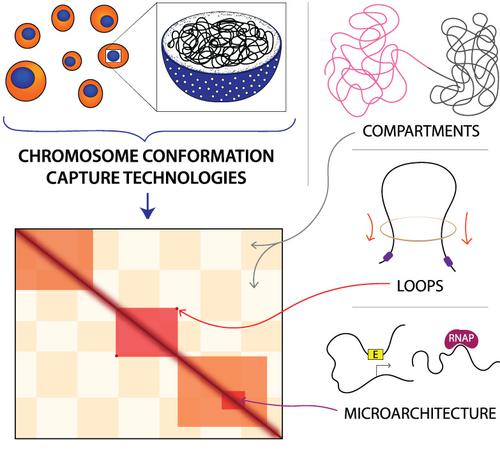当前位置:
X-MOL 学术
›
WIREs Mech. Dis.
›
论文详情
Our official English website, www.x-mol.net, welcomes your
feedback! (Note: you will need to create a separate account there.)
The macro and micro of chromosome conformation capture
WIREs Mechanisms of Disease ( IF 4.6 ) Pub Date : 2020-09-28 , DOI: 10.1002/wdev.395 Viraat Y Goel 1 , Anders S Hansen 1
WIREs Mechanisms of Disease ( IF 4.6 ) Pub Date : 2020-09-28 , DOI: 10.1002/wdev.395 Viraat Y Goel 1 , Anders S Hansen 1
Affiliation

|
The 3D organization of the genome facilitates gene regulation, replication, and repair, making it a key feature of genomic function and one that remains to be properly understood. Over the past two decades, a variety of chromosome conformation capture (3C) methods have delineated genome folding from megabase-scale compartments and topologically associating domains (TADs) down to kilobase-scale enhancer-promoter interactions. Understanding the functional role of each layer of genome organization is a gateway to understanding cell state, development, and disease. Here, we discuss the evolution of 3C-based technologies for mapping 3D genome organization. We focus on genomics methods and provide a historical account of the development from 3C to Hi-C. We also discuss ChIP-based techniques that focus on 3D genome organization mediated by specific proteins, capture-based methods that focus on particular regions or regulatory elements, 3C-orthogonal methods that do not rely on restriction digestion and proximity ligation, and methods for mapping the DNA–RNA and RNA–RNA interactomes. We consider the biological discoveries that have come from these methods, examine the mechanistic contributions of CTCF, cohesin, and loop extrusion to genomic folding, and detail the 3D genome field's current understanding of nuclear architecture. Finally, we give special consideration to Micro-C as an emerging frontier in chromosome conformation capture and discuss recent Micro-C findings uncovering fine-scale chromatin organization in unprecedented detail.
中文翻译:

染色体构象捕获的宏观和微观
基因组的 3D 组织有利于基因调控、复制和修复,使其成为基因组功能的一个关键特征,也是一个有待正确理解的特征。在过去的二十年中,各种染色体构象捕获(3C)方法已经描述了从兆碱基级区室和拓扑关联域(TAD)到千碱基级增强子-启动子相互作用的基因组折叠。了解基因组组织每一层的功能作用是了解细胞状态、发育和疾病的门户。在这里,我们讨论用于绘制 3D 基因组组织图的基于 3C 的技术的演变。我们专注于基因组学方法,并提供从 3C 到 Hi-C 发展的历史记录。我们还讨论了基于 ChIP 的技术(专注于特定蛋白质介导的 3D 基因组组织)、基于捕获的方法(专注于特定区域或调控元件)、不依赖限制性消化和邻近连接的 3C 正交方法,以及作图方法DNA-RNA 和 RNA-RNA 相互作用组。我们考虑来自这些方法的生物学发现,检查 CTCF、粘连蛋白和环挤压对基因组折叠的机制贡献,并详细介绍 3D 基因组领域当前对核结构的理解。最后,我们特别考虑 Micro-C 作为染色体构象捕获的新兴前沿,并讨论最近的 Micro-C 研究结果,以前所未有的细节揭示了精细尺度的染色质组织。
更新日期:2020-09-28
中文翻译:

染色体构象捕获的宏观和微观
基因组的 3D 组织有利于基因调控、复制和修复,使其成为基因组功能的一个关键特征,也是一个有待正确理解的特征。在过去的二十年中,各种染色体构象捕获(3C)方法已经描述了从兆碱基级区室和拓扑关联域(TAD)到千碱基级增强子-启动子相互作用的基因组折叠。了解基因组组织每一层的功能作用是了解细胞状态、发育和疾病的门户。在这里,我们讨论用于绘制 3D 基因组组织图的基于 3C 的技术的演变。我们专注于基因组学方法,并提供从 3C 到 Hi-C 发展的历史记录。我们还讨论了基于 ChIP 的技术(专注于特定蛋白质介导的 3D 基因组组织)、基于捕获的方法(专注于特定区域或调控元件)、不依赖限制性消化和邻近连接的 3C 正交方法,以及作图方法DNA-RNA 和 RNA-RNA 相互作用组。我们考虑来自这些方法的生物学发现,检查 CTCF、粘连蛋白和环挤压对基因组折叠的机制贡献,并详细介绍 3D 基因组领域当前对核结构的理解。最后,我们特别考虑 Micro-C 作为染色体构象捕获的新兴前沿,并讨论最近的 Micro-C 研究结果,以前所未有的细节揭示了精细尺度的染色质组织。











































 京公网安备 11010802027423号
京公网安备 11010802027423号